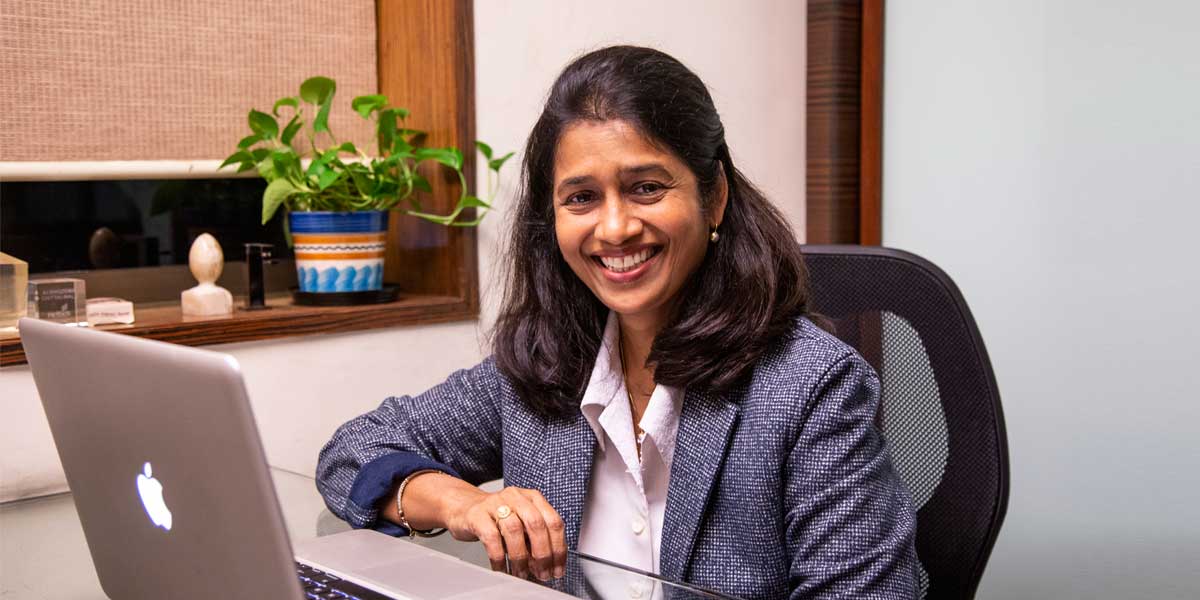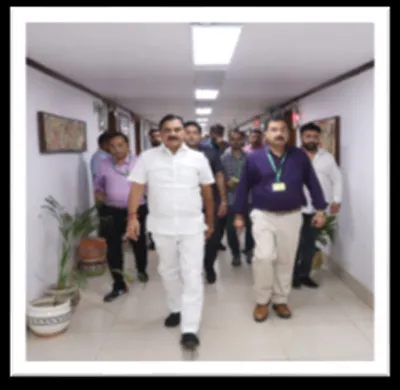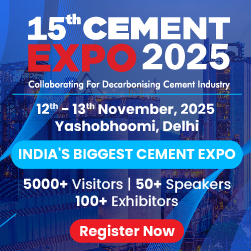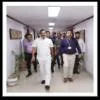- Sujata Chitalwala
CW Design Build spoke Sujata about her vision for the company, challenges in work, her expertise in soft furnishings and more.
What is your vision for The Designers Group?
With Designers Group, the vision is to make it a company that can become a holistic consultancy for the hospitality sector. Designers Group is a leading interior design and architectural firm that highlights brand-strengthening designs while infusing a sense of luxurious grace, comfort, style and innovation into the simplest of spaces. The team at Designers Group have thus, mastered the art of creating timeless ambiences of grandeur delicately blended with warmth to delight even the most critical eye, with a commitment to excellence in hospitality design.
How has your design philosophy changed over time, especially in the light of the pandemic? What changes have you made in your work protocol due to the pandemic?
Yes, the pandemic has changed the way we approach a design, considering there is now a strict protocol to be followed. The design methodology utilised within the industry has branched out to be more collaborative and digital in nature. Technological advancements have further aided in the increasing demand for smart buildings, more so during the pandemic.
Technological advancements and user-interactive design strategies are being explored by us for refined design sensibilities. In order to keep up with optimum hygienic standards, there is less incorporation of textured surfaces that have gained traction over the years. Hence, this has increased the use of stone & tile work with less demand for carpeted areas. A lot of the common areas such as pools, health clubs and spas are now completely redesigned to meet the new social distancing norms of today.
The team at Designers Group is keeping a keen check on the hygiene levels being maintained in the standards of air conditioning, material, furniture etc.
How do you approach design to accommodate aesthetics and functionality in residential, commercial or hospitality projects?
We place high regard on the client’s brief. It is pertinent to first understand the client’s requirements thoroughly. We aim to bring balance in the need for expression of one’s own unique design style versus practicality and what the client needs.
We, at Designers Group, design projects mostly based on regional influences and local nuances. Moreover, giving a local sway to the design lets the guests connect with the heritage, history and legacy of the region. Nature also has been one of our great sources of inspiration. Our notion is to deliver the essence of indigenous architecture through a contemporary design language while aiming to achieve efficient design schemes.
How do you incorporate sustainability in your work?
Energy conservation is a major revenue bustler when it comes to hospitality projects. It is one of the essential aspects in regard to all project typologies. We incorporate sustainability in terms of light, electricity and HVAC with the help of their respective consultants. There is now a heightened understanding that every project planned and every solution integrated causes carbon footprints and it is our responsibility to balance out the same.
The team is currently working on numerous solar efficiency-driven projects where a quantum of solar energy is generated and consumed at the same time by the hotel property. The ultimate notion is to give guests an extraordinary hospitality experience while balancing out energy consumption.
Which of your projects to date has been the most innovative and experimental and how?
In our core-hospitality career spanning 20 years, Designers Group has successfully completed around 150-200 projects which include part renovation, greenfield, brownfield and other typologies. Some of our recently completed projects are Devi Ratn- Jaipur, Radisson Hotel- Mumbai, Radisson Blu- Alibaug, Pride Plaza- Aerocity, Bellevue Sarovar Portico- Junagadh, Vivanta by Taj- Lucknow, Four points by Sheraton- Bangalore and Lucknow, Marriott- Surat.
With every project, the idea is to evolve with the completion of each venture as it stimulates design thinking and the creative learning process. We vouch for guest compliments and the experience feedback which the client receives, as, for us, client satisfaction and appreciation hold utmost importance. Hence, we aim to deliver innovative designs with all our projects.
Our first hospitality project, with the Taj President, is close to our hearts. At that point in time, this opportunity looked like a long-lasting desire coming to reality. This project gave us the opportunity to understand how international architecture firms function as Hirsch Bedner Associates was involved in the project. Thus, there was a higher learning curve which also involved innovative design styles in its interiors.
How would you define your style of design & aesthetics? How do you ensure that your projects bear your signature?
With every project, we aim to give a local sway to the designs. These further aids the guests to connect with the history and legacy of the region. In this globalised world, the notion is to emphasize local authenticity with no compromise on the cosmopolitan standards as well as the customer base. Offering the hotel interiors, a custom local touch helps to present a connection of the hotel to the region’s culture and heritage. Thus, with the design of branded luxury hotels, we try to maintain a refined balance between an authentic design and the associated baseline expectations that have become virtually universal in the luxury market that is surrounding the hospitality space.
We ensure to offer custom-designed accessories in our interior designs, thus majorly contributing to driving value in hospitality spaces. We ensure to make use of concepts inspired by local elements in our projects, thus creating authentic interiors while keeping luxurious comfort intact.
Tell us more about the effect soft furnishing has on the mood of any space.
It is imperative that the interior design of spaces pleases both the mind and the body. There are subliminal triggers in the interiors that cause changes in one’s mood and mental health. Here are a few instances where furnishings can influence one’s mood and temperament.
Colour - The choice of colour used in indoor spaces has a profound impact on one. While the use of red exudes the feeling of passion and power, blue accents tend to evoke serenity and tranquillity in their surroundings. Thus, it is vital to understand the proper usage of colour before finalising a colour scheme.
Furniture Arrangement - The position of the furniture determines the movement pattern in the space. It is ideal to set a focal point to arrange furniture along with a statement piece to organise a comfortable layout while enhancing the space utility. For instance, crowded furniture offers a sense of suffocation & anxiety but it also might not be the best idea to line the furniture up against the wall.
Inclusion of Natural Elements - It is no question that proximity to nature can lift one’s mood in many ways. Wooden interiors bring in a feeling of calmness and indoor planters make one feel rejuvenated and peaceful. Moreover, the visual sight of plants also accentuates memory retention and inspires productivity.
Symmetric Shapes - Steer clear of angular shapes for a more welcoming interior layout. Curves and round shapes exude harmony and completion while angular lines depict efficiency and professionalism. Symmetry helps add a sense of balance to space, ultimately offering pleasing aesthetics and calm mental peace.
Lighting - Lighting is essential in influencing one’s mood in the interiors. Extremely bright light can make one feel anxious while dull light can cause depression. Brightly illuminate the interiors in natural light and soulful artificial light in the latter half of the day. Ensure to have soft lighting in the private room to build a more relaxed retreat.
How has your design process evolved with years of experience?
Over the past two decades, our tremendous experience while being associated with numerous hotel projects from resorts to business hotels to mid-range brands has strongly made us feel that there is significant potential in the market for the growth of Indian hotel brands to create a better identity for themselves. It is now more about designing timeless yet quirky & minimalistic functional spaces where the final design output is straightforward and easy to navigate.
We are now more focused on ‘Experiential hospitality’ in the hospitality sector. We have now made it essential to include sustainability and energy conservation in our hospitality projects. We envisage a travel section for hotels in the future called the 'business leisure' segment, and thus delivering spaces in our projects that cater to the patrons that travel for business and make them feel at home away from home. A congenial design scheme is being outlined for luxury/presidential suites so that the guest can savour upon a more luxurious and stylish yet homey spirit.
With the unprecedented pandemic, we envisage a work from home environment in the hotel rooms/suites as well. Hence, technology is playing a vital role in our design schemes in not only incorporating strong wifi networks and smart touch but also advanced solutions for video conferencing and virtual meetings.
What changes have you perceived in your clients (in terms of demands, awareness, aesthetics, etc.)?
With the pandemic and changing trends, clients are now looking to incorporate materials like tiles, ceramics and marble more prominently in hospitality interiors. In India, it has now become quite common to find a preference for laminate wooden flooring.
There is another noticeable demand for vitrified flooring tiles. Their durability and availability in varied colours, polishes and finishes, prove to provide ambient aesthetics. Additionally, the surfaces can be conveniently kept hygienic and sanitised in the pandemic which has led to a higher demand for tiled finishes and less inclusion of carpeted flooring. Apart from this, there is also a rising trend incorporating design elements in the interiors with a strong focus on creating wall & floor art. This is accomplished by innovatively making use of waterjet cut patterns, custom-made terrazzo with metal inserts, patterned tiles in ceramics and natural stones cut in varied shapes forming different patterns.
Tell us about the projects you are working on currently?
Most of our ongoing projects are being catered towards the hospitality sector including both architectures as well as interior architecture projects. The nature of work at Designers Group accommodates all the categories of hotel projects ranging from 3-Star to 5-Star at a pan India level.
We have also been designing internationally as well. We are currently working on projects in Kathmandu, Nepal. Apart from this, we are also envisaging projects coming up in other countries.
What advice would you like to give to aspiring architects/designers?
My advice would be to think of tomorrow. When planning a layout or designing, one needs to always think of the future execution and the utilisation of space.




















